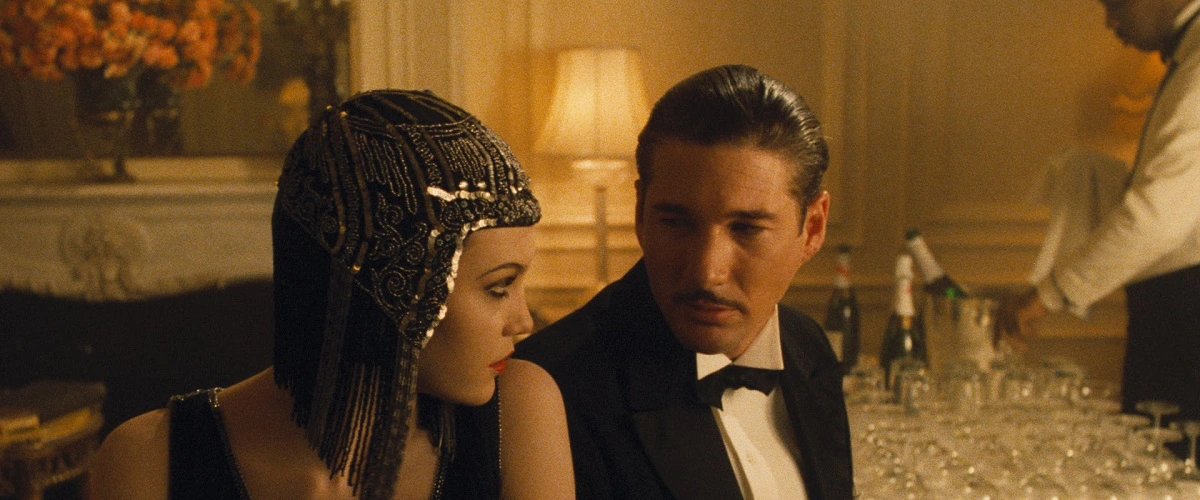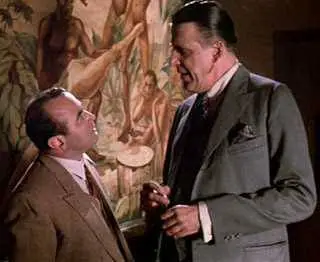Cotton Club: Encore
- 8 minutes read - 1561 words
- Format:
- Film
- Date Seen:
- 2022-09-18T12:30:00-04:00
- Venue:
- Alamo Drafthouse, Lower Manhattan
- Stars:
- ★★★
Amongst film fans, the story goes that “The Cotton Club” was undone by the studio and its meddlesome editing. It’s been circulated that the original cut was “too Black” and not “The Godfather” enough. Rumors aside, the fact stands that “The Cotton Club” released to theatres in December 1984 was a financial failure: after world-wide box office was totaled, the movie was still $10 million in the red.
Fast-forward 30 years, director Coppola has been re-cutting his movies so as to leave for posterity the versions he wants left e.g. the recent edits to “The Godfather.” “The Cotton Club” has been the latest beneficiary of Coppola’s time and wealth (he reportedly sank a half-million into this edit) and “Encore” was the result.
The new cut is still a damn mess. But scenes and passages of brilliance and beauty – some entirely new – have been restored or are more clearly showcased through the edit. The result doesn’t transcend confused direction, leaden acting, pointless arcs, and a dearth of romantic chemistry between Lane and Gere to be a masterpiece. Nevertheless…there is greatness in it, despite it not being great.
It’s a recommend, with some caveats.
A Sure Thing
Looking at the lineup years on, it’s hard to see how this could have been anything but a success:
- Richard Gere: just a moments away from “American Gigolo” and “Officer and a Gentleman”
- Gregory Hines: Tony award-winning dancer of sheer legend, occasional meet-cute interest to Miss Piggy
- Diane Lane: fresh off of “The Outsiders,” “Streets of Fire,” and “Fabulous Stains”
- Lonette McKee: Unknown to me, but what a voice, what a look!
- Gwen Verdon: Just, Gwen Verdon!
Seeing all those positives, and attendant dollar-signs, I suspect there were some tense and thank-god-that’s-not-on-tape discussions about the studio’s:
- Discomfort with the “Black storyline” (Hines and McKee) having equal footing to the White love triangle (Gere and Lane)
- Discomfort with facing the question of “passing” and racial admixture on the screen
- Discomfort with addressing why White immigrant men owned Black-neighborhood property and prevented Black residents from seeing Black performers in said Black neighborhood
- Discomfort with seeing Lawrence Fishburne’s “Bumpy Rhodes” beat a (White) bouncer who insults him along racial lines
The studio was clearly hoping for Godfather 3 (be careful what you wish for). As dailies and rushes came in, I suspect they saw their personal mint fall apart for something that was bound to rile up the latently-White-Supremacists, capitalists, and Morning in America types. A racially-conscious, Black-centering movie that, on top of it all, blurs genre boundaries between musical, Broadway, and drama (à la 2019’s “Rocketman” which it precedes by several decades) was not what they expected or wanted. To try to carve out a multiplex-friendly money-earner from Coppola’s footage, they savaged the print with their editors and produced an artistic malpractice that appealed to exactly no one.
Let’s talk about “Encore” and how it works.
The Great
First of all, any time Gregory Hines and/or his brother Maurice Hines are on screen, it’s pure magic. These legends of tap are deservedly legends and watching them is joyous.
Just…if you read nothing else, just watch Gregory Hines’ kinetic genius at work (spoiler alert: the dance is intercut with the Bad Guy getting his Just Desserts):
Next, I want to call out the bravery of Coppola’s chosen genre format. While we’re used to musicals featuring people singing through the pain, and we’re familiar with dramas having action and no songs, “The Cotton Club” allows music to serve as a mental expression of the characters’ mindset (à la “Rocketman” or “In the Heights”). Lauren pointed out that the dynamic is close to “Cabaret,” where the songs echo, prefigure, or deepen the narrative film around it. I loved this directorial decision.
Also, I loved the final number where the cast in the “Cotton Club” make their adieu on stage in the club from a set that looks like Grand Central Station. The camera stands in for us, the audience, as we watch the farewells. But then, through the number, the camera starts looking from backstage out into the audience and instead of seeing the backs of the performers and ourselves reflected (à la Cabaret’s mirror), we see them doing the same dance moves, from behind, in the actual Grand Central station. It prefigures certain video memes on TikTok or other internet media sites where a jump or hand swipe across the lens seamlessly blends into a new state or costume change. This is done wonderfully and beautifully with careful editing and creates joy. It’s a farewell number, and, as the living and dead head to their connections in the station, the play between the stage and the stage of life generates happy bliss. Oh! And when Gwen Verdon gives an impromptu lesson to a busker girl in the arrivals hall, it’s magic.
The Good
As far as sets and costumes go, no expense was spared and Lane’s costumes are staggering achievements of sequin and sparkle. She and Gere, washed in light, look spectacular and vintage in that way only Coppola can seem to do without it feeling gimmicky.

Should we go be beautiful together somewhere else?
The movie also features two nuanced and engaging performances by Bob Hoskins and Fred Gwynne as gangsters who realize that the Italians are about to make a play for Harlem and they’d best stitch up their profits and get out while they can still get out without being carried in a coffin. While it’s not heavy-handed, I believe these characters are gay or gay-coded and provide a more diverse representation of shady impresario than we normally see (yet another thing the studio probably blanched at).

Hm, that leg seems suggestive…
What’s also good is the daringness of taking on hard racial politics. I’d never even heard of “passing” until I was in my early 20’s in California – despite being raised in the South. To examine just how Black someone has to be before they start getting excluded was a really daring place for a director to go digging (especially a White director). The scenes were Hines and McKee discuss the politics of passing as a means of opportunism, capitalism, station, and shame are some of the best performances in the movie.
The Not-So Great
My brilliant wife compared “The Cotton Club” to “Cabaret” and I think this was genius. The films are very similar, especially in their use of an “inside the demimonde of club” countered by the “real world.” But whereas “Cabaret’s” Fosse limited the issues and scope of “Cabaret,” Coppola goes maximalist and, I think, bites off more than he can chew in a reasonable runtime. I think this is why the studio thought they could “save” the movie with editors. They thought there was a “Godfather 3” lurking in there that they could chisel out of “The Cotton Club.” In the “Encore” edit, Coppola didn’t cut quite ruthlessly enough to reveal the masterpiece inside. It’s better, but it’s still not great. The edit failed to weld the long running girders through the 2 hour and 19 minute runtime successfully. Ideas feel half-baked or “who cares.” That said, I love a noble maximalist failure (Infinite Jest, most Neal Stephenson books, et al.), and the Encore edit fits that description.
Finally, some of the plot elements just flat-out don’t work per se or are frankly boring. They distract from the (derivative) “under the thumb of a bad sugar daddy in a bad way” star-crossed romance of Lane and Gere and the joyous, insightful romance between Hines and McKee. Here are a few stinker arcs:
- Nicolas Cage as a Nicolas Cage doing a tough guy is unhinged and distracting. Cutting every one of his scenes and associated arcs would have had no effect on the movie (except make it shorter and more coherent)
- The love triangle between Gere and Lane doesn’t particularly smolder and it doesn’t really feature anything novel. If anything, the dullness of it seems to be an intentional foil to make the studio-disfavored “Black” storyline be tenfold more engaging. It’s “Breakfast at Tiffany’s” if the narrator weren’t gay and played the coronet
- Also not great is the gangster movie that keeps interrupting Hines’ dance numbers and Gere’s coronet solos. The scenery-chewing gangster of James Remar’s “Dutch Schultz” steals the energy, logic, and vision from most scenes he’s in. Remar’s performance can’t decide if he’s doing a commedia dell’arte stock character suitable for stage boos and hisses or if he’s trying to be Don Corleone. And frankly, I’m not sure the director knew either. I don’t fault Remar, here. Some communication clearly didn’t work
As Roger Ebert’s Odie Henderson nailed it:
…“The Cotton Club” played like an intriguing, gorgeously shot and designed musical that kept getting rudely interrupted by a crappy mobster movie.
– Source
Spot. On.
Conclusion
I’d recommend “Encore” over the original cut and I’d recommend the film be watched for its dancing and its music. One could, frankly, skip the non-performance scenes and have a jaw-dropping experience. Hines’ take on “Tall, Tan, Terrific,” added in this edit, has been playing in my head all day with joy and love. Since that addition isn’t on YouTube, let me give you some of the best dancing you’ll ever see in this life:
It’s ain’t real life, it’s jaaaazzzzz (possibly the world’s least-memorable tagline ever; and isn’t that “Chicago’s” line?)